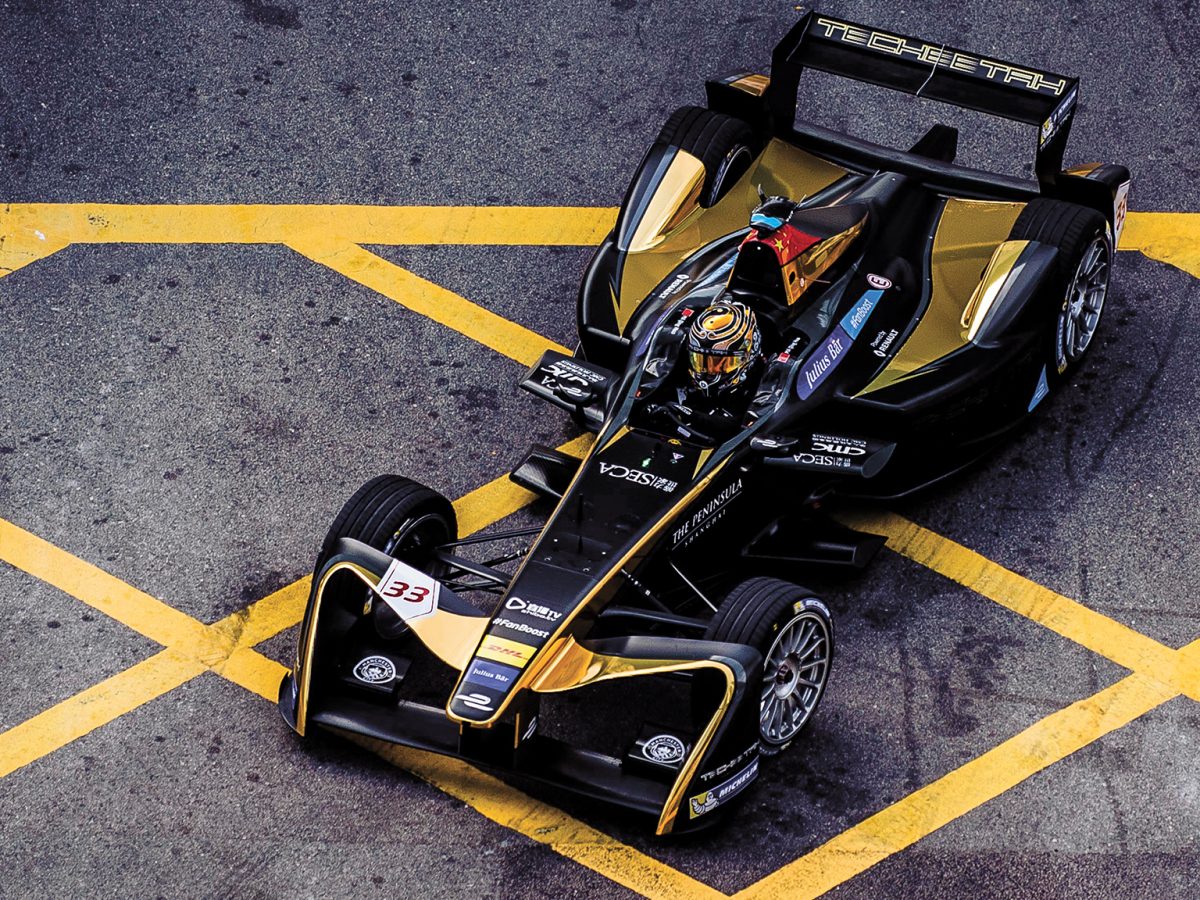November 14, 2018
How Did Formula E Minnows Techeetah Win the Drivers’ Championship?

This article was originally published in Populous Magazine, our biannual publication featuring news, information, and trends from the worlds of sport, entertainment, and major public events. Find out more, and sign up to receive a free copy, here.
The Chinese-backed start-up dominated the giants of the ePrix scene in only its second season.
If the underdog was ever going to land a punch, to stake a claim, then what better setting than New York City, that towering symbol of enterprise and endeavour, of risk and reward, where anything is possible as long as you dream big enough? It was here, around the streets of Brooklyn, against the backdrop of Manhattan’s pumped skyline, that Techeetah, an off-the-shelf, independent racing outfit stared down Formula E’s heavyweights… and won.
On the same weekend that France’s soccer team triumphed in the World Cup, Jean-Eric Vergne (left) made it a French double by taking the Formula E drivers’ championship. Were it not for a time penalty imposed on Vergne’s teammate, André Lotterer, Techeetah might have taken the teams’ championship, too, ahead of automotive giant Audi.
So how did this Chinese-backed start-up upset the Goliaths of the ePrix scene over the 12-race season? Techeetah’s team principal, Mark Preston, helps deconstruct the magic.
In F1 the difference in power between top and bottom is high. In FE the power cap means you can compete.
Cost-effective & power-capped
The FIA Formula E Championship, to give it its full title, is a racing series in which the cars are powered by battery, the sport is relatively affordable, and a broad equivalence of technical performance is assured by the regulations. Unlike its older, more established sibling, Formula One, outcomes are not determined by budgets.
A Formula E team costs between £15 million and £30 million a year, about a tenth of what Formula One costs. So if you have the cash, you can buy a customer powertrain to fit into a universal chassis. Techeetah bought from Renault a unit that was exactly the same spec as that provided by a manufacture team like Audi. Power output is capped at 180KW, which propels the cars up to speeds of 225-250kph (140-155mph), and away you go.
“Motor sport comes down to three things: engine, aerodynamics and tyres,” explains Preston. “In F1 the difference in power between top and bottom is high. In FE the power cap means you can compete. The cars share the same chassis so there is no real difference in the aerodynamic side of things, and we don’t have multiple sets of tyres in the race – only two sets for each driver. Basically, FE reduces the parameters to make competition more equal. The difference is made by the driver and in any power efficiencies the engineers can make.”
Ownership & management
Preston has a deep motor sport background that began in F1 at Arrows, McLaren and Super Aguri before crossing into the electric field with Team Aguri at the inception of the FE series four years ago. When Team Aguri was looking for investment, Shanghai-based sports management company SECA, backed by Chinese Media Capital (which part-owns Manchester City FC), stepped in. “They specialise in sports rights and clubs,” Preston explains. “They looked at sports rights they could own for use in China. They saw FE and liked it. It appeals to investors looking at the green angle.”
SECA were also buying into Preston’s racing expertise and a team infrastructure that would return a first victory under the new Techeetah banner in the last race of the 2016/2017 season before turning base metal into gold this season. “We had Renault power, a great driver and a great team with a lot of experience, so that helped,” Preston adds.
In F1 the driver is only as good as the car beneath him.
Great driver
Vergne spent four seasons in F1 – three as a race driver with Toro Rosso and finally as a test driver at Ferrari. Unable to secure a race seat for 2015, he switched to FE. It proved the making of him. In F1 the driver is only as good as the car beneath him. Witness the struggles of two-time world champion Fernando Alonso, still regarded as the best pound-for-pound operator in the sport, labouring in midfield in an outpaced McLaren. In FE it is the driver who makes the difference, his judgment and timing extracting marginal gains from broadly similar cars.
“Jean-Eric has matured into a top-class driver,” Preston observes. “He puts it into the top five whenever he needs to. He is really, really quick, good at managing energy through the race, has great race craft, and can overtake and hold the lead.”
Bright future
Season five sees the big beasts of the automotive world enter the electric show with BMW, Mercedes, Nissan and Citroen luxury brand DS (turning Techeetah into a works team) lining up alongside Audi, Jaguar and Mahindra. Porsche have commited to entering in season six.
Battery technology has evolved sufficiently to power the cars through the whole race in the 2018/2019 season, without the need to swap vehicles. The races will take place on glamorous street circuits in cities including Paris, Rome, Monaco, Hong Kong, Berlin and Marrakesh as well as New York City. F1 might soon be turning green, not thanks to fuel economy, but with envy.
Originally published in issue 19 of Populous Magazine. Subscribe for free to receive a copy.
Lorem ipsum dolor sit amet consectetur, adipisicing elit. Non facere corporis et expedita sit nam amet aut necessitatibus at dolore enim quis impedit eius libero, harum tempore laboriosam dolor cumque.
Lorem, ipsum dolor sit amet consectetur adipisicing elit. Illo temporibus vero veritatis eveniet, placeat dolorem sunt at provident tenetur omnis, dicta exercitationem. Expedita quod aspernatur molestias eum? Totam, incidunt quos.
